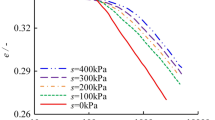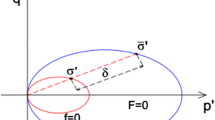Abstract
A modified two-surface critical state plasticity model for saturated and unsaturated soil is presented in this study. The key modification in new model is inclusion of an alternative yield surface used to simulate the behavior of unsaturated soils in addition to corresponding saturated conditions. Moreover, a numerical technique is used to obtain an incremental stress–strain response from loading curves. Modification is applied continuously in each incremental step to return the final stress states and hardening parameters to the yield surface. Results revealed that the adopted modeling approach can predict two independent sets of laboratory unsaturated experiments under various conditions satisfactorily. The model can well predict the augmentation of shear strength due to a rise in suction under different net stress levels. In addition, the influence of net stress on volumetric tendency was reliably simulated under drained conditions. The distinct feature of this model in capturing the suction-induced hardening and volumetric transition from dilation to contraction should be highlighted. It is also important to note that according to the results of hypothetical simulations, the stress–strain behavior of saturated coarse-grained soils can be rationally captured for a wide range of confining stresses and densities under both drained and undrained conditions.








Similar content being viewed by others
Abbreviations
- BR:
-
v
- \(A_{0}\) :
-
State constant in the simplest case
- \(A_{d}\) :
-
Function of the state
- C :
-
Apparent cohesion
- \(c^{c, b, d}\) :
-
Critical state variables
- \(C_{z}\) :
-
Fabric dilatancy constant
- \(C_{{\text{h}}}\) :
-
Hardening constant
- \(C_{m}\) :
-
Positive quantity and a function of state variables
- D :
-
Dilation coefficient
- e :
-
Porosity
- \(e_{{\text{c}}}\) :
-
Critical porosity ratio
- \(e_{{\text{c - ref}}}\) :
-
Model constant
- \(\dot{e}^{{\text{p}}}\) :
-
Deviatoric plastic strain rate tensor
- \(f\) :
-
Yield function
- \(G\) :
-
Shear modulus
- \(G_{0}\) :
-
Initial shear modulus
- \(h\) :
-
Positive scalar-valued
- \(h_{0}\) :
-
Positive constant
- \(I\) :
-
Unit quadratic tensor
- \(K\) :
-
Bulk volumetric module
- \(K_{{\text{p}}}\) :
-
Plastic modulus
- \(m\) :
-
Angle’s tangent attributed to yield surface opening
- \(\dot{m}^{p}\) :
-
Isotropic hardening
- \(M^{{\text{b}}}\) :
-
Bounding stress ratio
- \(M^{{\text{c}}}\) :
-
Critical stress ratio
- \(M^{{\text{d}}}\) :
-
Dilatancy stress ratio
- \(M_{{\text{c}}}^{{\text{b}}}\) :
-
Slope of bounding surface on the q-p space
- \(M_{{\text{c}}}^{{\text{c}}}\) :
-
Slope of critical state surface on the q-p space
- \(M_{{\text{c}}}^{{\text{d}}}\) :
-
Slope of dilatancy surface on the q-p space
- \(n\) :
-
Active loading
- \(N\) :
-
Volumetric component size
- \(n^{b}\) :
-
Factor of drained peak stress state
- \(n^{d}\) :
-
Factor of phase transformation
- \(p = (\sigma_{1} + 2\sigma_{3} ){/}3\) :
-
Confining stress
- \(P\) :
-
Confining pressure
- \(P_{{{\text{at}}}}\) :
-
Atmospheric pressure
- \(P_{{\text{c}}}\) :
-
Critical confining stress
- \(P\) :
-
Confining pressure
- \(q = \sigma_{1} - \sigma_{3}\) :
-
Deviatoric stress
- \(s\) :
-
Deviatoric stress tensor
- S :
-
Matric suction
- \(\left| u \right|\) :
-
Tensor size
- \(u:v\) :
-
Sum of the product of two adjacent tensors
- \(z\) :
-
Fabric-dilatancy tensor-valued variable
- \(z_{\max }\) :
-
Highest value of z
- \(\alpha\) :
-
Angle’s tangent attributed to bisector surface
- \(\alpha_{\theta }^{c, b, d}\) :
-
Deviatoric stress ratios that are functions of Lode angle
- \({\varvec{\alpha}}\) :
-
Deviatoric back-stress ratio tensor/axis direction of the yield surface
- \(\dot{\user2{\alpha }}^{p}\) :
-
Kinematic hardening
- \({\varvec{\alpha}}_{{{\text{in}}}}\) :
-
The value of \({\varvec{\alpha}}\) at the initiation of a loading process
- \({\varvec{\alpha}}^{c, b, d}\) :
-
Deviatoric back-stress ratio tensors related to critical, boundary, and dilative surfaces
- \({\varvec{\alpha}}_{{\varvec{\theta}}}^{{\varvec{b}}}\) :
-
Current state of stress image on the boundary surface
- \({\varvec{\alpha}}^{c. b. d}\) :
-
Deviatoric back-stress ratio tensors related to critical, boundary, and dilative surfaces
- \(\dot{\varepsilon }_{{{\text{pl}}}}\) :
-
Plastic strain rate
- \(\varepsilon^{{\text{p}}}\) :
-
Plastic strain
- \(\eta = q{/}p\) :
-
Deviatoric stress ratio
- \(\theta\) :
-
The Lode angle of n
- \(\lambda\) :
-
Model constant
- \(\nu\) :
-
Poisson’s ratio
- \(\xi\) :
-
Model constant
- \(\sigma_{1} . \sigma_{2} . \sigma_{3}\) :
-
Principal effective stress
- \(\partial f{/}\partial \sigma\) :
-
The gradient of yield surface
- \(\partial g{/}\partial \sigma\) :
-
The gradient of potential function
- \(\psi = e - e_{c}\) :
-
State parameter
- \(\omega\) :
-
Direction of triaxial shearing
References
Schofield AN, Wroth CP (1968) Critical state soil mechanics. McGraw-Hill, London
Manzari MT, Dafalias YF (1997) A critical state two-surface plasticity model for sands. Geotechnique 47(2):255–272
Taiebat M, Shahir H, Pak A (2007) Study of pore pressure variation during liquefaction using two constitutive models for sand. Soil Dyn Earthq Eng 27(1):60–72
Sadrnezhad SA (2002) Constitutive model for multi-laminate induced anisotropic double hardening elastic-plasticity of sand. Int J Eng 15(2):115–124
Sadrnejad SA (2002) A sub loading surface multilaminate model for elastic-plastic porous media. Int J Eng 15(4):315–324
Sadeghi H (2016) A micro-structural study on hydro-mechanical behavior of loess. PhD dissertation, Hong Kong University of Science and Technology
Alonso EE, Gens A, Josa A (1990) A constitutive model for partially saturated soils. Géotechnique 40(3):405–430
Wheeler SJ, Sharma RS, Buisson MSR (2003) Coupling of hydraulic hysteresis and stress–strain behaviour in unsaturated soils. Géotechnique 53(1):41–54
Lloret-Cabot M, Wheeler SJ, Sánchez M (2016) A unified mechanical and retention model for saturated and unsaturated soil behaviour. Acta Geotech 12(1):1–21
Lai BT, Wong H, Fabbri A, Branque D (2016) A new constitutive model of unsaturated soils using bounding surface plasticity (BSP) and a non-associative flow rule. Innov Infrastruct Solut 1(1):1–8
Kai C, Li, Y (2016) A Study on unsaturated dynamic constitutive model under cyclic loading for western Sichuan Talus mixed soil. In: International symposium on environmental vibration and transportation geodynamics. Springer, Singapore, pp 291–303
Zou W, Wang X, Jun Z, Zhong H, Liang W (2018) Constitutive model for soaking-induced volume change of unsaturated compacted expansive soil. In: Proceedings of China-Europe conference on geotechnical engineering, pp 116–120
Ghasemzadeh H, Sojoudi MH, Ghoreishian Amiri SA, Karami MH (2017) Elastoplastic model for hydro-mechanical behavior of unsaturated soils. Soils Found 57(3):371–383
Yong X, Ye GY, XieY YB, Zhang S, Zhang F (2019) A unified constitutive model for unsaturated soil under monotonic and cyclic loading. Acta Geotech 14(2):313–328
Bardet J, Choucair W (1991) Linearized integration technique for incremental constitutive equations. Int J Numer Anal Methods Geomech 15:1–19
Been K, Jefferies M (1985) A state parameter for sands. Géotechnique 35(2):99–112
Casagrande A (1936) Characteristics of cohesionless soil affecting the stability of slopes and earth fills. J Boston Soc Civ Eng 23(1):13–32
Li XS, Wang Y (1998) Linear representation of steady-state line for sand. J Geotech Geoenviron Eng 124(12):1215–1217
Li XS, Dafalias YF (2000) Dilatancy for cohesionless soils. Geotechnique 50(4):449–460
Papadimitriou AG, Bouckovalas GD (2002) Plasticity model for sand under small and large cyclic strains: a multiaxial formulation. Soil Dyn Earthq Eng 22(3):191–204
Dafalias YF, Papadimitriou AG, Li XS (2004) Sand plasticity model accounting for inherent fabric anisotropy. J Eng Mech 130(11):1319–1333
Reichardt K, Nielsen DR, Biggar JW (1972) Scaling of horizontal infiltration into homogeneous soils. Soil Sci Soc Am J 36(2):241–245
LeBlanc C, Hededal O, Ibsen LB (2008) A modified critical state two-surface plasticity model for sand—theory and implementation. DCE Technical Memorandum, Department of Civil Engineering, Aalborg University, 8
Sheng D, Gens A, Fredlund DG, Sloan SW (2008) Unsaturated soils: from constitutive modelling to numerical algorithms. Comput Geotech 35(6):810–824
Garakani AA, Sadeghi H, Saheb S, Lamei A (2020) Bearing capacity of shallow foundations on unsaturated soils: analytical approach with 3D numerical simulations and experimental validations. Int J Geomech 20(3):04019181
Ishihara K, Tatsuoka F, Yasuda S (1975) Undrained deformation and liquefaction of sand under cyclic stresses. Soils Found 15(1):29–44
Sadeghi H, Kiani M, Sadeghi M, Jafarzadeh F (2019) Geotechnical characterization and collapsibility of a natural dispersive loess. Eng Geol 250:89–100
Ng CWW, Sadeghi H, Jafarzadeh F (2017) Compression and shear strength characteristics of compacted loess at high suctions. Can Geotech J 54(5):690–699
Li XS, Ming HY (2000) Unified modeling of flow liquefaction and cyclic mobility. Soil Dyn Earthq Eng 19(5):363–369
Khroshavan Azar A (1995) Problèmes de sols saturés sous chargement dynamique: modèle cyclique pour les sols et validation sur des essais en centrifugeuse. PhD dissertation, Villeneuve d'Ascq, École centrale de Lille
Uchaipichat A (2005) Experimental investigation and constitutive modelling of thermo-hydro-mechanical coupling in unsaturated soils, PhD Thesis, The University of New South Wales, Sydney
Sadeghi H, Chiu CF, Ng CWW, Jafarzadeh F (2020) A vacuum-refilled tensiometer for deep monitoring of in-situ pore water pressure. Sci Iran 27(2):596–606
Ahmadinezhad A, Jafarzadeh F, Sadeghi H (2019) Combination of water head control and axis translation techniques in new unsaturated cyclic simple shear tests. Soil Dyn Earthq Eng 126:105818
Ng CWW, Sadeghi H, Hossen SB, Chiu CF, Alonso EE, Baghbanrezvan S (2016) Water retention and volumetric characteristics of intact and re-compacted loess. Can Geotech J 53(8):1258–1269
Sadeghi H, Ng CWW (2018) Shear behaviour of a desiccated loess with three different microstructures. In: The 7th international conference on unsaturated soils (UNSAT2018), Hong Kong
Ng CWW, Sadeghi H, Jafarzadeh F, Sadeghi M, Zhou C, Baghbanrezvan S (2020) Effect of microstructure on shear strength and dilatancy of unsaturated loess at high suctions. Can Geotech J 57(2):221–235
Jafarzadeh F, Ahmadinezhad A, Sadeghi H (2021) Effects of initial suction and degree of saturation on dynamic properties of sand at large strain. Sci Iran 28(1):156–174
Acknowledgements
The inevitable role of late Prof. Sadrnejad in supervising this research cannot be denied. Although we were unfortunate to have his consent for the final manuscript, we believe that he had been one of the key contributors to this work. May his soul rest in peace and be rewarded according to a life of scientific contribution.
Author information
Authors and Affiliations
Corresponding author
Ethics declarations
Conflict of interest
The authors declare that they have no conflict of interest.
Additional information
Publisher's Note
Springer Nature remains neutral with regard to jurisdictional claims in published maps and institutional affiliations.
Rights and permissions
About this article
Cite this article
Vahdani, M., Hajitaheriha, M.M., Hasani Motlagh, A. et al. A Modified Two-Surface Plasticity Model for Saturated and Unsaturated Soils. Indian Geotech J 52, 865–876 (2022). https://doi.org/10.1007/s40098-022-00601-7
Received:
Accepted:
Published:
Issue Date:
DOI: https://doi.org/10.1007/s40098-022-00601-7




